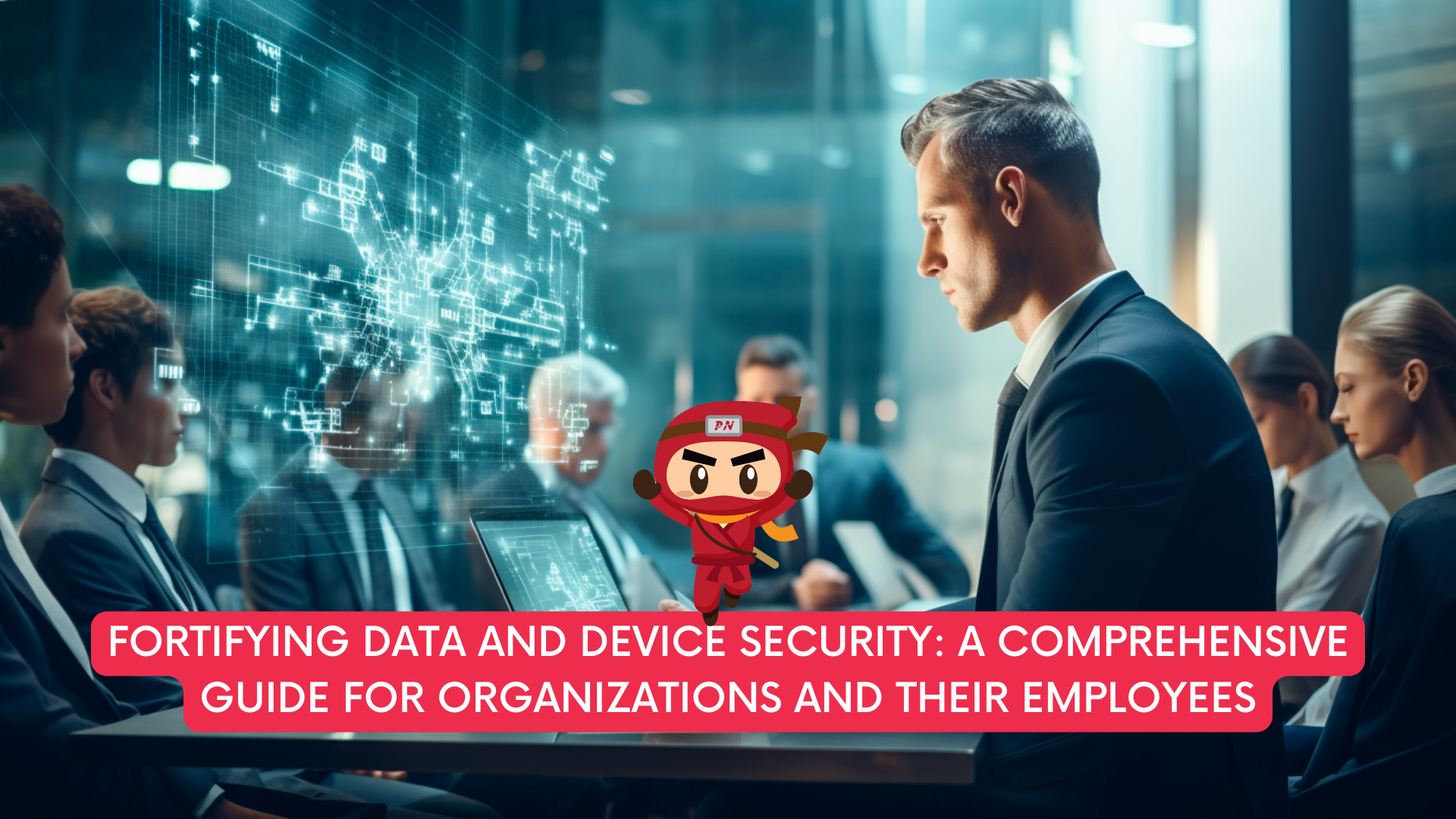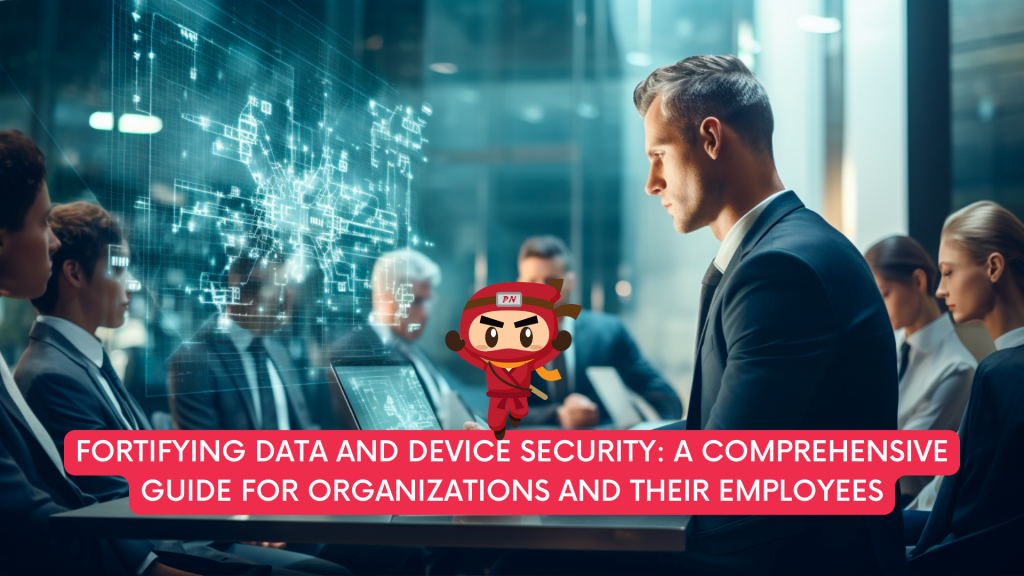KEEP IN TOUCH
Subscribe to our mailing list to get free tips on Data Protection and Cybersecurity updates weekly!







Safeguarding data and devices is paramount for organizations and individuals alike. Ensuring the security of valuable information assets is an ongoing process that demands continuous vigilance and adaptation in the face of evolving cyber threats. In this extended article, we will delve deep into the realm of data and device security, providing a comprehensive guide for organizations and their employees.
Effective data handling is the cornerstone of data and device security. It encompasses several key components that, when implemented diligently, can significantly fortify the protection of personal data.
1. Data Encryption: Data encryption is the process of converting data into a code to prevent unauthorized access. By encrypting sensitive data, organizations can ensure that even if it falls into the wrong hands, it remains unintelligible without the decryption key.
2. Data Access Controls: Strict access controls are vital to limit data access to authorized personnel only. These controls can be enforced through multi-factor authentication (MFA) and the principle of least privilege (PoLP), ensuring that individuals access only the data required for their specific roles.
3. Data Retention: Establishing a well-defined data retention policy is essential to determine how long data should be kept and when it should be securely disposed of. This not only streamlines data management but also minimizes the risk of data breaches.
4. Data Backup and Recovery: Regular data backup is the ultimate safety net against data loss due to cyberattacks or unforeseen incidents. It enables organizations to recover valuable information and resume operations swiftly in the face of adversity.

Data classification is a pivotal aspect of data and device security. It involves categorizing data based on its sensitivity, value, importance, and other relevant characteristics. When implemented strategically, data classification offers several critical advantages:
1. Enhanced Data Protection: By categorizing data, organizations can allocate resources and security measures more effectively to safeguard sensitive information. This ensures that the most valuable assets receive the highest level of protection.
2. Regulatory Compliance: Data classification assists in ensuring compliance with data protection regulations. Organizations can implement appropriate security measures for different categories of data, aligning with legal requirements.
3. Optimization of Data Handling Processes: A well-structured data classification strategy streamlines data management processes. It helps in determining data retention periods, access controls, and backup schedules, ultimately reducing the risk of data mishandling.
In today’s collaborative work environment, secure file sharing is essential for organizations. It involves employing encryption, access controls, and other security measures to protect files both during transit and while at rest. Secure file sharing offers various benefits:
1. Prevent Unauthorized Access: By implementing secure file sharing, organizations can prevent unauthorized individuals from accessing sensitive data. This safeguards confidential information and maintains data privacy.
2. Collaborative Workflow: Secure file sharing fosters collaborative work environments. It allows employees to share files with confidence, knowing that their data remains protected throughout the sharing process.
3. Compliance with Data Privacy Regulations: For organizations operating in highly regulated industries, secure file sharing ensures compliance with data protection regulations. This minimizes the risk of regulatory fines and reputational damage.

While much emphasis is placed on digital security, physical security is equally critical. It encompasses measures put in place to protect physical assets, facilities, and resources from unauthorized access, theft, damage, or harm. For organizations, enforcing physical security for devices is crucial to safeguard sensitive information and prevent potential security breaches.
1. Device Protection: Physical security measures include securing devices such as laptops, servers, and mobile devices. This involves implementing measures like access controls, surveillance, and alarms to deter theft and unauthorized access.
2. Access Control: Restricting access to server rooms and data centers is vital. Biometric or card-based access systems can ensure that only authorized personnel can enter these sensitive areas.
3. Surveillance and Monitoring: Surveillance cameras and monitoring systems can deter potential intruders and provide evidence in case of security breaches.
By combining digital and physical security measures, organizations can create a comprehensive security strategy that mitigates risks from multiple angles.
Lastly, one of the most critical aspects of data and device security is educating employees. In an organization, the human element can either be a strong defense or a significant vulnerability. Training employees on best practices for data and device security is vital to ensure that they are aware of potential threats and equipped to respond effectively.
Organizations should conduct regular security awareness training sessions, covering topics such as phishing prevention, password management, and safe online behavior. Employees should understand their roles and responsibilities in maintaining a secure environment and reporting security incidents promptly.
In conclusion, data and device security is a multifaceted endeavor that requires continuous commitment and vigilance. By implementing robust data handling practices, strategic data classification, secure file sharing, physical security measures, and comprehensive employee education, organizations can significantly enhance their security posture.
In a world where cyber threats continue to evolve, the security of data and devices is a shared responsibility. By following these guidelines, organizations and their employees can collectively contribute to a safer and more secure digital landscape. Embrace these best practices and make data and device security a top priority in your organization’s mission to protect valuable assets and maintain the trust of stakeholders.
Your appointed DPO can work with you on your PDPA compliance, ensuring that there will be policies in place to make sure that the handling of personal data is PDPA compliant.
A Data Protection Officer (DPO) oversees data protection responsibilities and ensures that organisations comply with the Personal Data Protection Act (PDPA). Furthermore, every Organization’s DPO should be able to curb any instances of PDPA noncompliance as it is the officer responsible for maintaining the positive posture of an organisation’s cybersecurity.
DPOs complement organisations’ efforts to ensure that the organisation’s methods of collecting personal data comply with the PDPA. It also ensures that policies are set in place to make sure that there will be no instances of data breaches in the future.
Don’t wait any longer to ensure your organisation is PDPA compliant. Take our free 3-minute PDPA Compliance Self-audit checklist now, the same “secret weapon” used by our clients to keep them on track. Upon completion, we will send you the results so you can take the necessary action to protect your customers’ data. Complete the free assessment checklist today and take the first step towards protecting your customers’ personal data.